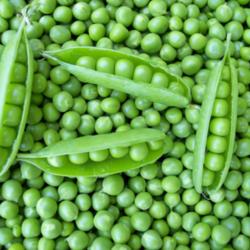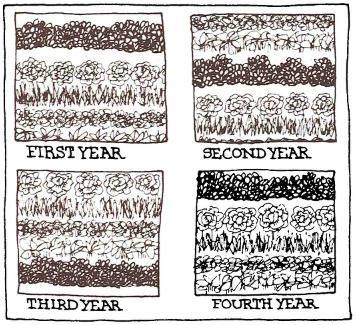
The best way to deal with problems is to avoid them in the first place. Here are some suggestions about how to prevent disease and insect problems in your garden before they even begin.
Prevention Steps
In the North, aphids and pea weevils are the most prevalent insect pests, wheras in the South the primary pest is the cowpea curculio. Blight, fusarium wilt, mosaic virus, powdery mildew and root rot are the most common diseases of peas.
Keep a careful watch over your garden. If problems arise, contact your extension service. Your local extension agent can advise you about how to deal with specific garden problems you may have.
The following guide will help you decide what problems may be bothering your crop.
Bacterial blight is a disease carried on infected seeds. Large, water-soaked spots appear on pea pods and irregular dark spots appear on leaves; cream-colored, shining ooze appears in the center of these spots. To avoid blight, plant certified disease-free seed on well-drained soil. Remove old pea vines and rotate your crops.
Cowpea curculio, a destructive southern pest, eats holes in peas and pods. To control, spray or dust with a registered pesticide.
Pea aphids are pear-shaped, long-legged, soft, green insects only 1/16 to 1/8 inch long. By sucking juices from the leaves and stems, they may cause withering of plants and stunting of crops, thus reducing yields.
Control aphids by gently rubbing them off leaves or spray infested areas with an insecticidal soap. Ladybugs and aphid lions are naturally occurring enemies that may be in your garden.
Pea weevils are microscopic pests that lay their eggs on developing legume seeds, on which the larvae then feed. Infested dry peas will be riddled with holes and small worms within weeks of storage. Reduce weevil problems by planting early and turning the plants under right after harvest. For best storage results, spread dried peas on a cookie sheet and place it in a 175oF oven for one hour. When cool, bag and freeze the peas for a week, then store them at room temperature.
DiseasesDamping-off fungi, which cause seed decay, are prevalent during cool, moist weather. To avoid this problem, plant only after the soil is dry enough to work easily.
Fusarium wilt causes pea leaves to turn yellow. The plants are stunted and eventually wilt. Fusarium wilt symptoms are similar to those of root rot. The main difference is that the base of the stem of a plant affected with wilt isn't withered, and the inside of the stem shows discoloration. This fungus lives in the soil and enters the plant through its roots. Check seed catalogs or seed packets for resistance to the disease. Fusarium-resistant varieties will be marked with an F. For other control measures see root rot.
Mosaic virus is spread by aphids and carried within infected seeds. The plants usually become stunted, leaves turn light colored and mottled, and pods are few and poor in quality. To reduce infection, remove pea plants that show leaf mottling and control aphids.
Powdery mildew is a fungal disease that's most troublesome in warm weather. A white or grayish powdery mold appears on the pods, leaves and stems. To combat this problem, turn under or compost the pea vines as soon as the harvest is over, water in the morning only and plant resistant varieties.
Root rot is caused by soilborne fungi that often kill plants at flowering time. Plants turn pale yellow and may be stunted. The stems wither near the ground, and the plants often die back or collapse. To avoid root rot, plant peas in well-drained soil. Remove and destroy affected plants. Rotate crops.
Precautionary Note:If you choose to use commercially available sprays or dusts, purchase the least-toxic preparation that will do the job effectively.
When using a commercial spray or powder, read the instructions three times: before buying to make sure you buy the right substance; before using to be sure you use it correctly; and again before storing in order to put it away properly.
It's often best to contact your local extension service for advice when a problem arises. Not only can extension agents help you to identify the unwanted pests in your garden, they'll also suggest the best remedy for dealing with them in your area.
 Victory Seed Company has all the seeds you want for your best garden in 2024.
Victory Seed Company has all the seeds you want for your best garden in 2024.
For 25 years, the family-owned Victory Seed Company has provided the highest quality vegetable, herb and flower seeds to families across the country. We are passionate about providing you the best seeds available that give excellent germination, robust plants, and the harvest you want. With a catalog of over a thousand varieties, we have everything, and our prices are the kinds that we'd want to pay. We have hundreds of yesterday's heirloom vegetables, as well as today's award winning hybrid selections. Get to know us by visiting our website and browsing through our online vegetable seed catalog.
| 1. Caring for Peanuts |
| 2. Caring for Peas |
| 3. Watering Peas |
| 4. Pesky Pea Problems ← you're on this article right now |
| 5. Peanut Problems |
| 1. Caring for Peanuts |
| 2. Caring for Peas |
| 3. Watering Peas |
| 4. Pesky Pea Problems ← you're on this article right now |
| 5. Peanut Problems |